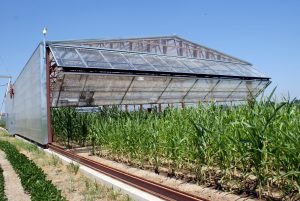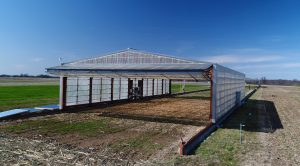This story also appears in our University of Missouri College of Agriculture, Food and Natural Resources’ Agricultural Research Center Magazine. Stop by your local Research Center to pick up a copy! You can view the magazine online by clicking here: Road to Discovery.
Droughts can have a devastating effect on farms. As one of the leading causes of crop failure, droughts impact consumer costs and livestock nutrition.
To combat these drought problems, researchers at the University of Missouri are keeping it dry every year in two drought simulators at the Bradford Research Center. The simulators enable scientists to study how reduced water availability affects plants and crop productivity.
The shelters look like 50-by-100-foot greenhouses on railroad tracks. They move away from test plants when the weather is sunny and cover the plots when rain approaches, allowing the crops under the shelter to experience drought-like conditions.
“This project provides Missouri scientists with state-of-the-art field facilities to conduct a broad range of drought-related translational research,” said Felix Fritschi, the C. Alice Donaldson Professor in Bioenergy Crop Physiology and Genetics in CAFNR’s Division of Plant Sciences, who leads the effort. “Our objective is to take laboratory discoveries in basic plant drought research and develop real-world products and practices to improve food security and increase profitability for farmers.

on farms. As one of the leading causes of crop failure, droughts impact consumer costs and livestock nutrition. To combat these drought problems, researchers at the University of Missouri
are keeping it dry every year in two drought simulators at the Bradford Research Center. The simulators enable scientists to study how reduced water availability affects plants and crop productivity.
“Water is a finite resource that is in great demand for a wide variety of reasons, including domestic, industrial, leisure, landscape and agricultural uses. In light of population increases and greater demands for non-agricultural water uses, more and more emphasis must be placed on efficient use of water resources for plant production. The drought simulators provide us with a new tool to study how agricultural water use efficiency can be improved.”
Fritschi received a $1.56 million grant in 2009 to construct the drought simulators. The Missouri Life Sciences Research Board grant funded the construction of four mobile rain shelters, which researchers use to vary the amount of water that test plants receive, simulating everything from short dry spells to persistent and severe drought conditions. The first two were built at the Bradford Research Center. Additional simulators have been built at the Fisher Delta Research Center, in Portageville,
and the Horticulture and Agroforestry Research Center, in New Franklin.
Plant responses to drought are complex and difficult to study, said Robert Sharp, a co-investigator and director of the campus-wide Interdisciplinary Plant Group (IPG)
at MU.
“The ability to manage the timing, duration and intensity of water-deficit stress under field conditions is essential to examine plant responses to drought,” Sharp said. “Thus, the drought simulators bridge the gap between controlled environment facilities, such as growth chambers and greenhouses, and real conditions encountered in the field.”
With the drought simulators in place, researchers are developing new germplasm with increased drought tolerance, discovering genetic and physiological mechanisms that underlie drought adaptation in plants, evaluating drought-related cultural practices that increase crop productivity and studying the influence of water deficit stress on soil-plant-insect and soil-plant-pathogen interactions.
In the Missouri River Basin, one part or another experienced drought in 90 out of the 100 years in the last century, according to the National Drought Mitigation Center. The impact of drought not only affects crop production but also strikes associated industries, such as the American beef cattle industry, which relies on grain crop production or forage to feed livestock. Yield limitations caused by water-deficit stress are likely to intensify, as most global circulation models call for climate scenarios that will worsen drought in many regions, Fritschi said.

“Furthermore, the growing world population increasingly competes for fresh water resources and will require greater productivity per unit of water and land,” Fritschi said. “Increased irrigation using nonrenewable water sources and progressing desertification further underline the urgent need for crop varieties that produce greater yields in water-limited environments.”
IPG researchers, a collaborative team of university and USDA scientists, offer expertise from disciplines including plant physiology, plant breeding, molecular biology, biotechnology, entomology, agronomy, plant pathology, turfgrass science, forestry and soil science. They’ve worked with scientists in Missouri as well as Australia, England, India, Mexico, the Philippines and several countries in Africa.
Of particular note, Sharp said, several members of the group have expertise in the critically important but under-studied area of root biology — including Fritschi and Henry Nguyen, a Curators’ Distinguished Professor in Plant Sciences. Sharp has been studying the physiology of root growth under drought since he joined MU in 1986.
The rain shelters, Sharp said, provide a vital facility for these and other MU researchers to translate their basic discoveries of drought to the delivery of more drought-tolerant crops to the doorsteps of American farmers.
“MU is a significant center of excellence in interdisciplinary plant biology,” Sharp said. “Several scientists who have been recruited have expanded on long-standing strengths in drought research on the MU campus.”